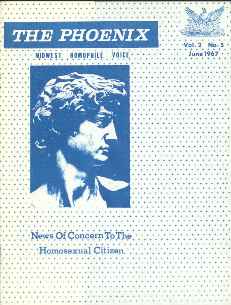History and background
The first issue in 1966 was originally titled The Phoenix: Homophile Voice of Kansas City, but was changed in the next issue to Midwest Homophile Voice. They were distributed at gay and straight clubs, LGBT meetings, social gatherings, college campuses, and other businesses sympathetic to the movement. [3] [4] The magazine even made its way to Iowa and Nebraska. [2]
The magazine had the typical fare for a homophile magazine: poetry, artwork, cartoons, short stories, and it also delved into serious issues like the psychological aspects of homosexuality, and gave counsel about legal rights for LGBT citizens, in case of an interaction with law enforcement, or medical professionals. [3] [5] The magazine was financially supported by advertising revenue from local gay establishments, mostly gay bars in the area. [6] [7]
Shafer's parents were very supportive of their son and his LGBT activism. Shafer's father was a commercial printer, and he was instrumental in obtaining printing equipment for the periodical, installing an old linotype machine in the basement of the Phoenix House. The magazine was created using paste-up boards, and hand drawn graphics. [7] His mother, Phyllis Shafer, was a LGBT activist herself, and wrote under the pseudonym 'Estelle Graham' for the magazine. [8] In the July 1966 issue, she penned an essay titled "A Mother's Viewpoint On Homosexuality". [1] [2]
After their successful start in publishing their own magazine, Shafer consented to be a publishing clearinghouse for the North American Conference of Homophile Organizations, in August 1966. They reprinted magazines, newsletters, and pamphlets from other homophile organizations from around the United States, including: Tangents, Vector and the Homophile Action League newsletter. They also put together North American Conference of Homophile Organization periodicals, and circulated them across the US. [3] According to Stuart Hinds, co-founder of the Gay and Lesbian Archive of Mid-America, "Kansas City became the information distribution center for the homophile movement". [2] [9]
By 1972, Shafer had accumulated an enormous amount of debt ($50,000), trying to keep his publishing business going, and keeping the Phoenix House open. Advertising revenue from the magazine had dramatically dwindled as well, so the magazine ceased publication, and the house was forced to close. [2]
Legacy
In 2016, a historical marker was installed by the Gay and Lesbian Archive of Mid-America, at Barney Allis Plaza in downtown Kansas City, commemorating Shafer's magazine The Phoenix: Midwest Homophile Voice, and his work with The Phoenix Society. [5] [10]
In 2021, a traveling exhibit featuring some of Shafer's magazines, and his publishing network, along with his work with the Phoenix House, was on display at the Missouri State Museum inside the state capitol. It was put together by students at the University of Missouri-Kansas City, and was focused on local Kansas City LGBT history. [3] [2] However, after four days it was removed from the capitol building, after complaints it was "pushing the LGBT agenda" in the state capitol. The complaints reportedly came from Republican legislators and their staff. [11] [12] [a]
This page is based on this
Wikipedia article Text is available under the
CC BY-SA 4.0 license; additional terms may apply.
Images, videos and audio are available under their respective licenses.
